By Dr Raghuram Y.S. MD (Ay) & Dr Manasa, B.A.M.S
Grahas are psychosomatic diseases afflicting children due to evil forces. Graha is a name given to the planets or unseen organisms. It was believed that some unknown and invisible entities would produce a few diseases and they were called Graha’s.
When compared with the modern day diseases the Graha’s can be compared to the micro-organisms like viruses, bacteria etc. Graha’s were said to bother the children more than the adults.
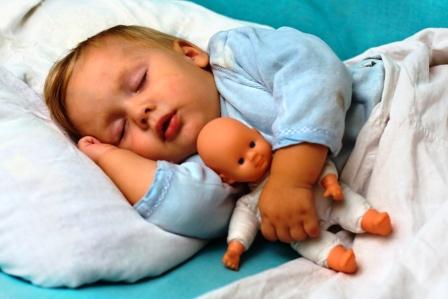
Table of Contents
Signs and symptoms of Skanda Graha
- Tears from one eye
- The child often jerks the head violently
- One side of the body or parts of one side of the body become function-less
- Stiffness of the body parts
- Sweating
- The neck becomes curved or bent
- Grinding of teeth
- Rejects breast milk
- Feared
- Cries making awkward sounds
- Face becomes twisted
- Vomiting of saliva excessively
- Child gazes upwards
- Smell of muscle-fat or blood emitted from the body of the child
- Terrified
- Clenches fists
- Constipation
- Movement of one eye, one cheek and one eyelid
- Redness of both eyes
- Deformities of body parts
- Death
- Tremors (Yoga Ratnakara)
- Undistinguished weeping (Yoga Ratnakara)
Read – Symptoms That Hint Towards Different Diseases In Babies
Sanskrit Verses
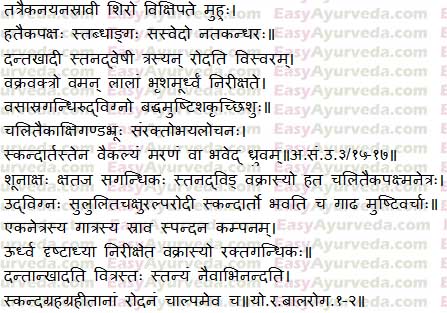
Modern correlation
This condition can be closely compared to ‘hemiplegia with facial paralysis in children’.
We do not find many instances when we find both hemiplegia and facial paralysis symptoms found at the same time, in a given child. The below mentioned conditions shall be considered in comparative study with its Ayurveda counterpart.
Alternating hemiplegia – also known as crossed hemiplegia is a form of hemiplegia in which we can find ipsilateral and contralateral presentation in different parts of the body. Superior alternating hemiplegia i.e. Weber Syndrome presents with contralateral hemiparesis of limb and facial muscles along with weakness in one or more muscles that control eye movement on the same side. There is loss of eye movement due to damage of oculomotor nerve fibers. There is increased weakness in upper and lower extremities. Another type of this hemiplegia i.e. Middle alternating hemiplegia or Foville Syndrome presents with weakness of the extremities accompanied by paralysis of the extraocular muscle, on the opposite side of the affected extremities.
Alternating Hemiplegia of Childhood (AHC) – is a rare neurological disorder that usually occurs in children before 18 months of age. It causes recurrent episodes of hemiplegia that involves one or both sides of the body, multiple limbs or a single limb. Paralysis may affect different parts of the body at different times. The symptoms disappear during sleep and return on awakening. Many children display some degree of developmental delay, abnormal eye movements, uncontrolled limb movements and seizures.
Central facial palsy – presents with paralysis of lower half of one side of the face. It often occurs in patients who are hemiplegic. Symptoms include dysfunctions in the facial expressions, difficulty in communication and impairment of sucking, swallowing and talking.
Facial Paralysis in Children – Since the facial symptoms dominate the picture of Skand Grah, we shall discuss about the facial paralysis in brief. It is caused by damage to the seventh cranial nerve i.e. facial nerve. This nerve governs the sensation and movement of all the muscles in the face. Damage to this nerve causes inability to move one or both sides of the face. This affects the child’s ability to convey emotion through facial expression, blink, speak and eat. It may be caused due to Bell’s palsy, trauma during child birth, head injury, Moebius syndrome or tumors.
Symptoms include drooping on one side of the face due to muscle weakness, asymmetrical smile, inability to blink, drooling, difficulty feeding and speech problems, most of which are seen in children afflicted by Skanda Graham.
Congenital facial paralysis – is uncommon. When it is present, it might cause multiple problems for the newborn. Asymmetrical facial movement, difficulty in nursing and incomplete eye closure is common symptoms. On long run it might affect the speech, expressions and mastication in the child. This may be traumatic or developmental, unilateral or bilateral and complete or incomplete paralysis.
Treatment
1. Internal medication
Rasna – Devadarvadi Ghrita / Ksheera Pana
Ghee processed with paste of Pluchea lanceolata or Cedrus deodara and milk should be given to drink. Alternatively milk processed with the same herbs and herbs having sweet taste should be given for drinking.
Dashamuladi Ghrita Pana
The ghee processed with milk mixed with the decoction of Dashamula or paste of Kakolyadi group of sweet tasting herbs is given to drink.
Read – Which Ayurvedic Medicines Are Not Safe For Children? How To Know?
2. External measures
a. Anointment
Gugguluvadi Churna Lepa
Soft powder of the below mentioned herbs should be prepared and applied on the body of the child –
- Guggulu – Commiphora mukul
- Elavaluka – Prunus cerasus
- Manashila – Realgar
- Haratala – Orpiment
- Manjishta – Rubia cordifolia
- Ushira – Vetiveria zizanioides
- Rasna – Pluchea lanceolata
- Aguru – Aquilaria agallocha
- Devadaru – Cedrus deodara
- Shriveshtaka – Clitoria ternatea
- Harenu – Pisum sativum
- Girikadamba – Neolamarckia cadamba
- Sandalwood – Santalum album
Read – Infant Care As Per Ayurveda: Initial 6 Months
b. Bath
Vatahara Kwatha Snana
Bath should be given with the decoction prepared with leaves of vata mitigating plants.
Read – How To Make Ayurvedic Herbal Bath Powder At Home?
c. Massage
Vata Nashaka Taila Abhyanga
Oil processed and prepared with the decoction of the roots of Vata mitigating herbs and fragrant herbs should be used for massage.
Kantakaryadi Taila Abhyanga
Oil prepared with the below mentioned herbs shall be used for giving massage –
- Kantakari – Solanum xanthocarpum
- Brihati – Solanum indicum
- Punarnava – white and red varieties of Boerhavia diffusa
- Renuka – Vitex agnus-castus
- Pippali – Piper longum
- Musta – Cyperus rotundus
- Khadira – Acacia catechu
- Vacha – Acorus calamus
- Shankhanabhi – kind of a shell
- Sarala – Pinus roxburghii
- Sarpasugandha – Rauwolfia serpentine
- Devadaru – Cedrus deodara
Sarvagandha Dravya Siddha Taila Abhyanga
Massage shall be given with the oil prepared with ‘Sarvagandha Dravyas’ i.e. fragrant herbs, sura-manda i.e. scum or froth of bear, Mahanimba (Melia azedarach) etc.
Read – Oil Massage To Baby: Precautions, Method, Ayurvedic Oil Combinations
d. Fumigation
Vachadi Dhupa
Fumigation should be given with the below mentioned things –
- Vacha – Acorus calamus
- Gunja – Abrus precatorius
- Skin of snake
- Mustard
- Hairs of camel, goat, sheep, horse and cow
- Ghee
Sarshapadi Dhupa
Fumigation with the powder of the below mentioned ingredients should be given –
- Mustard seeds
- Rala – Shorea robusta
- Kushta – Saussurea lappa
- Hingu – Asafetida
- Guggulu – Commiphora mukul
Read – Guggul Benefits, Usage, Dose, Side Effects, Research
Sarpagandhadi Dhupa
Fumigation is given with Rauwolfia serpentine, nails and hairs of goat.
e. Parishechana – showering
Vata Nashaka Parishechana
Sprinkling done with the decoction prepared from the leaves of vata mitigating herbs like Bilwa, castor or Rasna. The roots of the same herbs shall be used to process sesame oil and this oil shall be used to give full body massage.
3. Ritualistic measures
a. Bheshaja Dharana – wearing medicaments
a. The below mentioned herbs should be tied in a bolus and tied in the neck of the child afflicted by Skand Graha –
- Guduchi – Tinospora cordifolia
- Durva – Cynodon dactylon
- Shami – Prosopis cineraria
- Bilwa Kantaka – thorns of Aegle marmelos
- Indravaruni – Citrullus colocynthis
Read – Bael Root, Fruit And Stem, Uses, Research, Remedies, Side Effects
b. The seeds of the below mentioned should be tied in a bolus and tied around the neck of the child. Alternatively the seeds shall be tied to the arm or wrist.
- Nakuli – Rauvolfia serpentine
- Ajagandha – Cleome gynandra
- Tikta koshataki – Luffa acutangula
- Indravaruni – Citrullus colocynthis
- Shatavari – Asparagus racemosus
- Sahadevi – Vernonia cinerea
- Punarnava – Boerhavia diffusa
b. Bali – sacrifice
The below mentioned should be offered as sacrifice to the Skanda Grah –
- Red garland
- Red anointments
- Red clothes
- Red banners
- Gems
- Sesame
- Varieties of dishes
- Curds
- Ghee
- Honey
- Parched grains
- Meat
- Fish
- Fermented drinks, wine
- Peacock
- Cock
- Red colored rice etc
These should be sacrificed in the main roads or at the roots of the latex yielding trees.
Later the child should be given a bath on the river bed. Following this, the below mentioned hymn should be recited.

Read – Ayurvedic Home Remedy For Baby Care – A Traditional Method
c. Havana – fire worship
At the night, the fire should be lit up and should be offered with oblations of honey and ghee after chanting the below mentioned hymn –
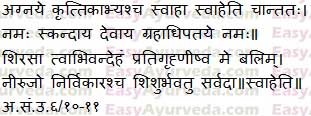
For three nights, the mother / wet-nurse and the child should be bathed with water consecrated by ‘Gayatri Mantra’ hymn. The mother and child shall be seated at the junction of four roads.
Read – Analysis Of Effect of Mantras On Health And Nadi
d. Marjana – Raksha Sutra
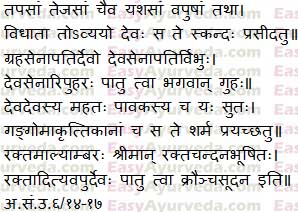
The child should be subjected to sprinkling / body wash with the water consecrated with the above mentioned hymn, thrice in a day. A carrying girth made up of consecrated threads should be tied around the wrists of the child. This is said to protect the child from the evil spirits.
Skandapasmara Graha
Signs and symptoms
- Child suddenly goes unconscious and suddenly gets back to consciousness
- Throws away his hands and legs in a bizarre way as if dancing
- Voids feces and urine while throwing his limbs
- Bowing of body
- Severe yawning
- Frothing from the mouth
b. Symptoms from Yogaratnakara
- When child loses consciousness, he vomits foam
- When child gains consciousness, he cries and screams a lot
- Smell of pus and blood from the body
c. Symptoms from Ashtanga Samgraha
- Loses consciousness often
- The child pulls his hairs
- The neck gets crooked
- Bending of body
- Yawning
- Repeated voiding of feces and urine
- Vomiting of foam
- Eyes gazed in upward direction
- Rapid movements, as if dancing, of hands, eyebrows and feet (lower limbs)
- Bites the breasts of his mother or his own tongue
- Agitated
- Fever
- Sleeplessness
- Emits smell of pus and blood from the body
Read – Your Child Does Not Eat Well? Causes, Ayurveda Solutions
Sanskrit Verses
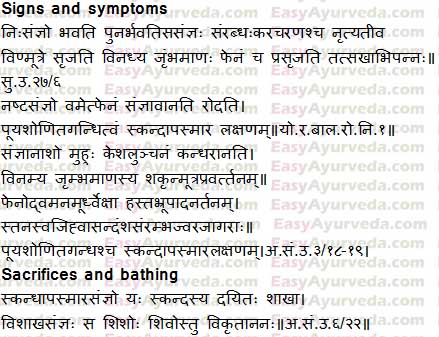
Modern Correlation
The main symptoms of Skandapasmaram resembles ‘epileptic attacks in children’ explained in modern texts.
Epilepsy is quite common in childhood. Epilepsy causes seizures which begin in the brain. Most often it is found that adults with epilepsy have had their first episode of seizure in childhood or adolescence. According to the Epilepsy Foundation, 2/3 children with epilepsy outgrow seizures by the time they reach their teenage. Good and comprehensive care help many children get rid of seizures and in prevention of side effects. Seizures are common in the first year of life.
Read – Epilepsy – Ayurvedic Understanding And Its Treatment
Types of childhood epilepsy and symptoms
Focal seizures and generalized seizures are the two main types of seizures.
Focal seizures / partial seizures – affect only one side of the brain. The child experiences an aura before seizure. This signals the arrival of seizures. The auras of seizure may include changes in hearing, vision or smell, unusual feelings, such as fear, euphoria or sense of déjà vu. Focal aware seizures affect a specific muscle group such as those in fingers or legs. There is no loss of consciousness. The child having focal aware seizure may appear frozen. The child is unable to respond but can usually hear and understand things which occur in the surroundings. Nausea, pale skin and sweating are also present. Focal impaired awareness seizures cause loss of consciousness or awareness of surroundings. Symptoms like crying, laughing, staring and smacking of lips are present.
Generalized seizures – affect both sides of the brain. It usually causes loss of consciousness. After the attack, the children are sleepy and tired. This is called postictal state. It is of the below mentioned types –
- Absence seizures / Petit-mal seizures – presents with brief loss of consciousness. Staring, rapid blinking of eyes and facial twitching are the other symptoms. This is most common in age groups of 4-14 years. The seizures last less than 10 seconds. There is absence of postictal state.
- Atonic seizure / drop seizures – there is sudden loss of muscle tone. The child may fall down or limp and stop responding. The attack usually lasts less than 15 seconds.
- Generalized tonic-clonic seizure (GTC) / Grand mal seizure – first there is contraction, then straightening and then shaking of child’s body and limbs. Later the muscles contract and relax. Finally there is postictal period. Here the child becomes tired and confused. The attack usually last for 1-3 minutes.
- Myoclonic seizure – causes sudden jerking of muscles and the seizures last for 1-2 seconds. There may not be loss of consciousness.
Read – Nocturnal Enuresis – Bed Wetting In Children: Treatment
Childhood Epilepsy Syndrome
- Benign Rolandic Epilepsy of Childhood – occurs between 3-10 years of age and affects about 15% of children with epilepsy. Focal seizures might occur at night and may develop into GTC. Seizures may rarely occur during wakefulness. They usually involve twitching of the face and tongue.
- Childhood absence epilepsy – usually affects children under 16 years of age. It begins between 4 and 10 years of age. The caregivers may not take a note since the absence seizures are very brief.
- Infantile spasms / West Syndrome – usually begin before a child is 1 year of age. There are brief spasms or jerking in one or more parts of the body. The spasm occurs in clusters. This can affect infants who have had a brain injury. Many children with this syndrome have learning difficulties or behavioral problems. They may also develop another syndrome called Lennox-Gastaut Syndrome.
- Juvenile Myoclonic Epilepsy – begins between 12 and 18 years of age. This causes different types of seizures, including myoclonic seizures, tonic-clonic seizures and absence seizures. Flashing lights can trigger seizures. They may also occur shortly after waking up. It is the most common generalized epilepsy syndrome. It often continues into adulthood. Medication can control seizures in up to 90% cases.
- Landau Kleffner Syndrome – is a rare childhood disorder, begins between 3 and 7 years of age. It causes difficulties in understanding language and verbal expression. The child may also have behavior problems. About 70% children with LKS have obvious seizures. The seizures are usually focal.
- Lennox-Gastaut Syndrome – usually begins between 3-5 years of age and causes various kinds of seizures. Many children will have learning and behavior problems.
- Temporal Lobe Epilepsy – is the most common form of focal epilepsy. Symptoms usually occur between 10-20 years of age.
Read – My Child’s Intelligence Is Decreasing. 9 Tips To Improve
Causes of childhood epilepsy
In many cases no cause may be identified. Below mentioned are the potential causes or contributing factors of childhood epilepsy –
- Developmental disorders, autism
- Genetic types of epilepsy
- Infectious diseases like meningitis etc
- Head trauma
- Tumors / cysts in the brain
- High fevers (febrile seizures)
- Oxygen deficiency before or during birth
- Maternal infections and poor nutrition during pregnancy
Common trigger factors for childhood seizures
- Excitement
- Deficit sleep
- Flickering / flashing lights
- Missing medication for seizures
- Music, loud noises etc
Read – Charaka Apasmara Nidana: 8th chapter
Diagnosis
Below mentioned are the tools of diagnosis of childhood epilepsy –
- Complete medical and family history
- Details of episodes of seizure
- Thorough physical examination of the child
- Blood tests
- Brain scans and measurements – CT scan, MRI scan & EEG
Read – Ayurvedic Treatment For ADHD – Herbs, Therapies, Medicines, Remedies
Treatment
Medications – antiepileptic drugs to control the symptoms. These do not control seizures in all children.
Ketogenic diet – to control the seizures should be planned with the help of doctor and dietician.
Neuro-stimulation – done when the epilepsy do not respond to the drugs. They are of 3 types – vagus nerve stimulation, responsive neuro-stimulation and deep brain stimulation.
Surgery – is some cases surgery may be needed to remove a portion of the brain. They may prevent or reduce seizures.
Read – Charaka – Apasmara Chikitsa – 10th chapter
Ayurvedic treatment
1. Internal medication
Kshiri vriksha kwatha and Jivaniya Kalka Sadhita Ghrita Pana
Ghee prepared with the decoction of latex yielding trees or paste of Jeevaniya group of herbs should be given for oral consumption.
Kakolyadi Gana Siddha Ghrita Pana
Ghee prepared with decoction of Kakolyadi group of herbs and milk explained by master Sushruta should be given for oral consumption.
Read – When To Consume Ghee? Before Or After Food?
2. External measures
a. Anointment
Skandagrahokta Lepa – anointment explained in the context of child afflicted with Skanda Graha should be used in this context too –Gugguluvadi Churna Lepa
b. Parishechana / Snana – showering and bath
Durvadi Kwatha Parishechana / Snana
Showering and bath should be given to the child with decoction prepared using the below mentioned ingredients –
- Durva – Cynodon dactylon
- Bilwa – Aegle marmelos
- Shirisha – Albizia lebbeck
- Musta – Cyperus rotundus
- Tulasi – Ocimum sanctum
c. Abhyanga – massage
Sarpasugandhadi Taila Abhyanga
Oil processed with the below mentioned ingredients should be used to give body massage to the afflicted child –
- Paste of Rauvolfia serpentine
- Paste of Cedrus deodara
- Kushta – paste of Saussurea lappa
- Musta – paste of Cyperus rotundus
- Urine of cow
- Urine of goat
Read – Uses Of Animal Urine As Per Ayurveda
d. Fumigation
Fumigation should be given to the child with the below mentioned ingredients –
- Feces of vulture
- Feces of owl
- Body hairs of bull
- Human hairs
- Nails of elephant
- Ghee
3. Ritualistic measures
a. Raksha Sutra – protective measures through wearing / tying medicament
The below mentioned herbs shall be tied to the limbs, neck or head of the afflicted child –
- Anantamula – Hemidesmus indicus
- Kukkuti – Mallotus tetracoccus / Bombax ceiba / Physalis minima / Luffa echinata
- Kunduri – Coccinia grandis
- Manjishta – Rubia cordifolia
- Shweta kamala – white variety of lotus etc
b. Bali and Snana – Sacrifices and bathing
Raw or cooked meat, blood, curds and spirituous liquor should be offered as sacrifice at the roots of Banyan tree.

The child should be given with bath at the junction of four roads while reciting the above mentioned hymn.
Click to Consult Dr Raghuram Y.S. MD (Ayu) – Skype









